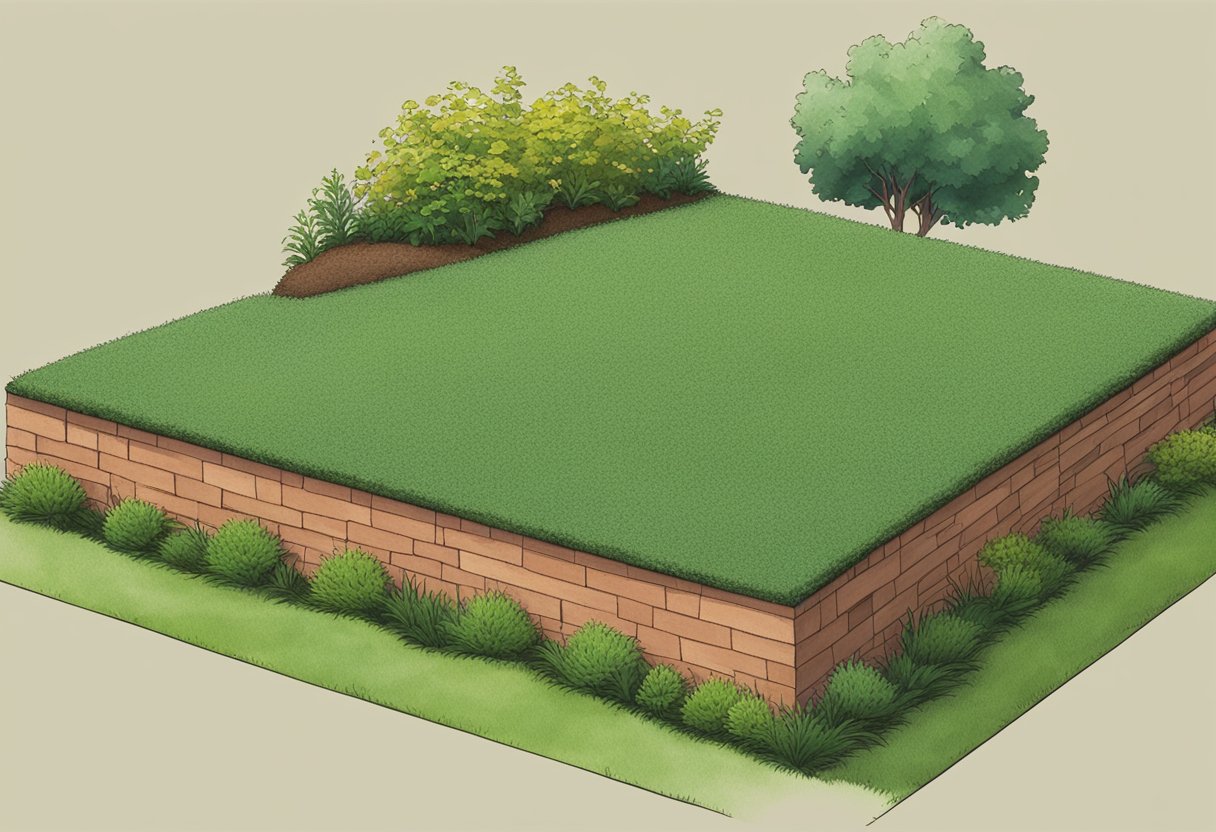Red Creeping Thyme Lawn: How to Grow and Maintain It
Red creeping thyme lawn is a ground cover that has been gaining popularity in recent years due to its low maintenance and eco-friendly nature. This plant is a type of thyme that spreads quickly and forms a dense mat of small leaves and vibrant red flowers. It is a great alternative to traditional grass lawns as it requires less water, fertilizer, and mowing.

One of the main benefits of a red creeping thyme lawn is its low maintenance requirements. Once established, it requires very little watering and can survive in poor soil conditions. It also does not need to be mowed frequently, as it only grows to a height of about 2-3 inches. This makes it an ideal option for those who want a beautiful lawn without the hassle of constant upkeep.
In addition to being low maintenance, a red creeping thyme lawn is also eco-friendly. It does not require the use of harmful pesticides or fertilizers, making it a safer option for pets and children to play on. It also attracts pollinators such as bees and butterflies, which helps to support local ecosystems. Overall, a red creeping thyme lawn is a great choice for those who want a beautiful and sustainable lawn.
Understanding Red Creeping Thyme
Red creeping thyme, also known as Thymus Serpyllum, is a popular perennial plant that is commonly used as a lawn alternative. This fragrant plant is a member of the thyme family, Thymus Praecox, and is native to Europe and Asia. In this section, we will explore the botanical profile, varieties, and benefits of red creeping thyme as a lawn alternative.
Botanical Profile: Thymus Serpyllum
Red creeping thyme is a low-growing, mat-forming plant that typically reaches a height of 3 to 6 inches. It has small, oval-shaped leaves that are green in color and turn a reddish hue in the fall. The plant produces tiny, pink to purple flowers that bloom in the summer and attract bees and other pollinators.
Red creeping thyme is a hardy plant that prefers full sun and well-drained soil. It is drought-tolerant and can withstand moderate foot traffic, making it an ideal lawn alternative for areas with low to moderate use.
Varieties and Their Characteristics
There are several varieties of red creeping thyme, each with its own unique characteristics. Some popular varieties include:
- ‘Coccineus’: This variety has bright red flowers and a strong, spicy fragrance.
- ‘Elfin’: This variety has small leaves and pink flowers.
- ‘Magic Carpet’: This variety has dark green leaves and pink flowers.
Benefits as a Lawn Alternative
Red creeping thyme is an excellent lawn alternative for several reasons. First, it requires little maintenance once established, making it a low-maintenance option for homeowners. Second, it is drought-tolerant and can withstand moderate foot traffic, making it an ideal option for areas with low to moderate use. Third, it is a fragrant plant that attracts bees and other pollinators, making it a great option for those looking to support local ecosystems.
In addition, red creeping thyme is a visually appealing plant that adds color and texture to any landscape. Its low-growing habit makes it an excellent option for edging or filling in gaps in a garden bed.
Overall, red creeping thyme is a versatile and attractive lawn alternative that is well-suited to a variety of landscapes. With its low maintenance requirements, drought tolerance, and fragrant blooms, it is a great option for homeowners looking to reduce their water usage and support local ecosystems.
Preparation for Planting
Before planting red creeping thyme, it is important to properly prepare the area to ensure optimal growth and health of the plants. This section will cover the necessary steps to take before planting, including soil requirements, choosing the right location, and clearing the area of weeds and debris.
Soil Requirements and PH Levels
Red creeping thyme prefers well-draining soil with a pH level between 6.0 and 8.0. It is important to test the soil in the area where the thyme will be planted to ensure it meets these requirements. If the pH level is too low, add lime to the soil to raise it. If it is too high, add sulfur to lower it.
In addition to pH levels, the soil should be rich in organic matter. Adding compost to the soil before planting will help provide the necessary nutrients for the thyme to thrive.
Choosing the Right Location
Red creeping thyme requires full sun to grow properly, so it is important to choose a location that receives at least six hours of direct sunlight per day. The area should also be well-drained to prevent water from pooling around the plants.
Clearing the Area of Weeds and Debris
Before planting, it is important to clear the area of weeds and debris. Weeds can compete with the thyme for nutrients and water, while debris can create an uneven surface for planting. Use a garden hoe or rake to remove any weeds or debris from the area.
Once the area is cleared, it is recommended to add a layer of mulch to help retain moisture in the soil and prevent weeds from growing back. This will also help keep the area looking neat and tidy.
By following these steps, you can ensure that your red creeping thyme lawn will have the best chance of thriving and providing a beautiful and fragrant addition to your landscape.
Planting Your Red Creeping Thyme Lawn

Best Time to Plant
The best time to plant red creeping thyme lawn is in the spring or late spring when the soil has warmed up and the risk of frost has passed. This will give the plants enough time to establish themselves before the hot summer months.
Step-by-Step Planting Guide
- Prepare the soil by removing any weeds, rocks, or debris.
- Loosen the soil to a depth of 6-8 inches using a garden fork or tiller.
- Mix in compost or other organic matter to improve soil fertility and drainage.
- Water the soil to moisten it before planting.
- Plant the plug plants 6-8 inches apart, pressing them firmly into the soil.
- Water the plants thoroughly after planting to help them establish.
Watering Needs During Establishment
During the establishment period, which usually lasts about 4-6 weeks, it is important to keep the soil moist but not waterlogged. Water the plants deeply once or twice a week, depending on the weather conditions. Avoid overhead watering as this can lead to fungal diseases. Once the plants have established, they will require less frequent watering.
By following these simple steps, you can successfully plant and establish a beautiful red creeping thyme lawn.
Caring for Your Thyme Lawn

Watering and Drought Tolerance
Red creeping thyme is a drought-tolerant plant that can survive long periods without water. However, it is important to water your thyme lawn regularly during the first few weeks after planting to help it establish its roots. Once established, you can reduce watering to once or twice a week, depending on the weather conditions. It is important to avoid overwatering as this can lead to root rot.
Fertilizing and Nutrient Requirements
Red creeping thyme is a low-maintenance plant that does not require much fertilizing. However, you can use bone meal or rock phosphate to provide it with the necessary nutrients. Apply the fertilizer once a year in the spring to promote healthy growth.
Dealing With Pests and Diseases
Red creeping thyme is generally free from pests and diseases. However, you may occasionally encounter some problems such as spider mites, aphids, or root rot. To prevent these issues, it is important to maintain good air circulation and avoid overwatering. If you notice any signs of pests or diseases, you can use insecticidal soap or neem oil to treat the affected area.
Pruning and Maintenance
Red creeping thyme is a low-maintenance plant that requires minimal pruning. However, you can trim it back in the spring to encourage new growth and maintain its shape. It is also important to remove any dead or damaged leaves to prevent the spread of disease.
Overall, caring for your thyme lawn is easy and straightforward. By following these simple tips, you can enjoy a beautiful and healthy lawn that requires minimal maintenance.
Design and Aesthetic Considerations

When considering integrating red creeping thyme into a lawn, it is important to keep in mind the design and aesthetic aspects. Red creeping thyme is a versatile plant that can be used in a variety of ways to enhance the look of an outdoor space.
Integrating With Other Plants
Red creeping thyme can be used to complement other plants in a garden. It pairs well with lavender, elfin thyme, and wooly thyme, creating a beautiful and fragrant combination. When selecting other plants to integrate with red creeping thyme, it is important to consider their light and water requirements to ensure they are compatible.
Using as Groundcover in Walkways and Pathways
Red creeping thyme is an excellent ground cover for walkways and pathways. It can withstand light foot traffic and releases a pleasant fragrance when stepped on. When using red creeping thyme as a ground cover, it is important to ensure that the soil is well-draining to prevent waterlogging.
Creating Patterns and Textures
Red creeping thyme can be used to create patterns and textures in a lawn. It can be planted in between pavers to create a unique and eye-catching design. When planting red creeping thyme in a pattern, it is important to ensure that the spacing is consistent to create a cohesive look.
Overall, red creeping thyme is a versatile plant that can enhance the design and aesthetic of an outdoor space. Its ability to complement other plants, withstand foot traffic, and create unique patterns and textures make it an excellent choice for use in retaining walls, walkways, and pathways.
Environmental Benefits and Considerations

Water Conservation and Xeriscaping
Red creeping thyme is an excellent option for those who want to conserve water and practice xeriscaping. As a perennial plant, it requires little water once established, making it an eco-friendly choice for those living in drought-prone areas. In fact, it is considered a xeriscape plant, which means it can thrive in low-water conditions.
Attracting Pollinators and Wildlife
Red creeping thyme is a great option for those who want to attract pollinators and wildlife to their lawn. The plant produces small, fragrant flowers that are attractive to butterflies and bees. Additionally, the plant provides cover and food for small animals such as rabbits and deer.
Impact on Local Ecosystems
While red creeping thyme is generally considered an eco-friendly option, it is important to consider its impact on local ecosystems. As a non-native plant, it may compete with native plant species for resources. However, it is not considered invasive and is unlikely to cause significant harm to local ecosystems.
In summary, red creeping thyme is a great option for those looking for an eco-friendly, low-water lawn alternative that attracts pollinators and wildlife. While it is important to consider its impact on local ecosystems, it is generally considered a safe choice.
Troubleshooting Common Issues

Red creeping thyme lawn is a beautiful and low-maintenance groundcover that can add color and texture to any landscape. However, like any plant, it is susceptible to a few common issues that can impact its growth and overall health. Here are some tips on how to troubleshoot these issues and keep your red creeping thyme lawn looking its best.
Managing Foot Traffic and Wear
One of the most common issues with red creeping thyme is damage from foot traffic and wear. This can cause the plants to become flattened or even die off in certain areas. To prevent this, it is important to limit foot traffic on the lawn as much as possible. If there are areas that receive a lot of foot traffic, consider adding stepping stones or a pathway to direct traffic away from the plants.
Preventing and Treating Root Rot
Another issue that can impact red creeping thyme is root rot. This is caused by overwatering or poor drainage and can result in the plants becoming wilted, yellowed, or even dying off. To prevent root rot, make sure that the soil is well-draining and that the plants are not overwatered. If you notice signs of root rot, such as wilting or yellowing leaves, it is important to remove any affected plants and replant in a new area with better drainage.
Controlling Invasive Growth
Red creeping thyme is a groundcover plant, which means that it can be invasive and spread quickly if not contained. To prevent this, it is important to regularly prune and trim the plants to keep them from spreading too far. You can also use barriers, such as edging or rocks, to contain the plants and prevent them from spreading into unwanted areas.
Overall, red creeping thyme is a beautiful and low-maintenance groundcover that can add color and texture to any landscape. By following these tips and troubleshooting common issues, you can keep your red creeping thyme lawn looking its best for years to come.
Cost and Installation

Estimating Cost for Homeowners
Red creeping thyme is a cost-effective alternative to traditional turf lawns. The cost of installing a red creeping thyme lawn varies depending on several factors, including the size of the area to be covered, the quality of the soil, and the availability of the plant. On average, homeowners can expect to pay between $0.50 and $1.50 per square foot for red creeping thyme ground cover, which is much cheaper than the cost of traditional sod.
In addition to the cost of the plant, homeowners should also consider the cost of preparing the soil and planting the thyme. The soil should be loosened and amended with compost or other organic matter to ensure proper drainage and nutrition for the plants. Homeowners can choose to plant the thyme from seed, or they can purchase established plants from a nursery.
DIY vs. Professional Installation
Homeowners can choose to install a red creeping thyme lawn themselves or hire a professional landscaper. DIY installation is a cost-effective option, but it requires a significant amount of time and effort. Homeowners will need to prepare the soil, plant the thyme, and maintain the lawn regularly to ensure its health and longevity.
Professional installation is a more costly option, but it can save homeowners time and effort. Professional landscapers have the expertise and equipment necessary to prepare the soil and install the thyme quickly and efficiently. They can also provide ongoing maintenance services to ensure the lawn remains healthy and beautiful.
Overall, homeowners should consider their budget, time constraints, and level of expertise when deciding whether to install a red creeping thyme lawn themselves or hire a professional. While DIY installation may be more cost-effective, professional installation can save time and provide peace of mind.
Frequently Asked Questions
What are the advantages and disadvantages of a red creeping thyme lawn?
Advantages of a red creeping thyme lawn include its low maintenance requirements, drought tolerance, and its ability to attract pollinators. Additionally, it has a pleasant fragrance and adds a unique aesthetic to any lawn. Disadvantages may include a slower growth rate compared to traditional grass lawns, and it may not be as durable for high traffic areas.
What common issues may arise with a red creeping thyme lawn?
Common issues with a red creeping thyme lawn include weed invasion and poor drainage. It is important to properly prepare the soil before planting and to regularly remove any weeds that may grow. Additionally, proper watering and drainage techniques should be implemented to prevent waterlogging and root rot.
How quickly can I expect red creeping thyme to cover a designated area?
Red creeping thyme typically spreads at a rate of about 6 to 12 inches per year. However, the rate of growth may vary depending on the soil conditions and climate.
Is red creeping thyme safe for areas frequented by dogs?
Red creeping thyme is generally safe for dogs and other pets. However, it is important to note that dogs may be attracted to the scent and may attempt to eat the plants. It is recommended to monitor pets and discourage them from eating the plants.
Can red creeping thyme effectively suppress existing grass when planted?
Red creeping thyme can effectively suppress existing grass when planted in a dense enough pattern. However, it may take some time for the thyme to establish and fully suppress the grass.
Where can I purchase red creeping thyme plants or seeds?
Red creeping thyme plants and seeds can be purchased from local nurseries, garden centers, and online retailers. It is recommended to purchase from a reputable source to ensure the quality of the plants or seeds.
